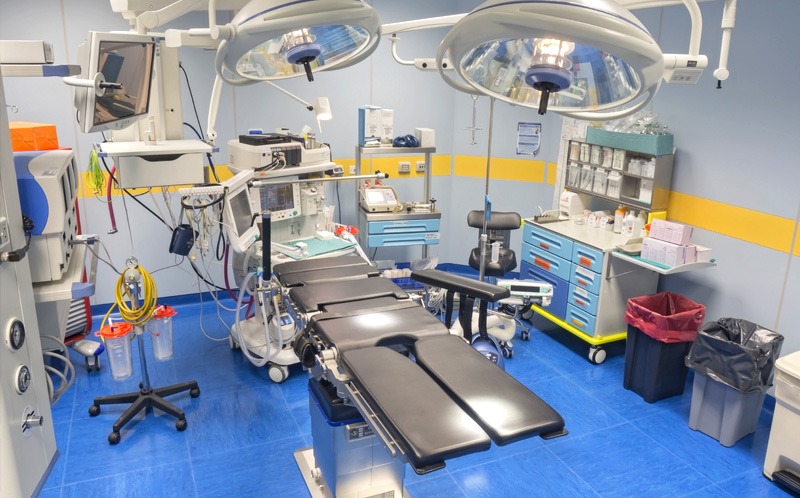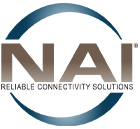
29 Jul Medical Trends and Devices That Require Cable Assemblies
NAI is a manufacturer and distributor of cable assemblies. Starting with copper, fiber optic, and hybrid cables, NAI creates organized assemblies and harnesses to suit the needs of clients in various industries.
Thanks to its proprietary Global Sourcing Program, NAI provides cable assemblies that are fully customized in many ways, from the types of cables used, to the insulation materials, to the connectivity options. These cable assemblies empower the operation of complex networks, including those found in hospitals and medical centers.
DISCOVER MORE ABOUT NAI GROUP’S WORK IN THE MEDICAL TECHNOLOGY SPACE
What Is a Medical Device Cable Assembly?
As its name indicates, medical cable assemblies incorporates groups of individual cables and connectors, to arrange them within fixed packages. The assembly prevents the inevitable tangling and wearing out that happens whenever you have loose cables, such as the ones that you’ve probably seen behind your home theater system or desktop computer.
Tangled or worn-out cables are inconvenient when they’re attached to home electronics, but they are extremely dangerous in a medical setting. A malfunctioning cable can render an entire equipment setup useless, putting the patient’s life at risk.
Cable assemblies also make it easy to set up these complex machine networks. Time-saving resources like this are invaluable in health care, where people move fast and resources are sparse. With cable assemblies, a team member can connect equipment quickly, delivering power to devices and transmitting data with vital patient information in a timely fashion.
Three Medical Devices that Require Cable Assemblies
Medical technology today can do some amazing things. The advanced machinery itself gets part of the credit, and rightly so. Defibrillators can restart a patient’s heart. Patient monitoring systems can notify a nurse down the hall if a patient’s vital signs drop below safe levels.
But none of those systems do any good if they can’t transmit signals from one component of the system to the next. The transmission medium is cable, and cables for medical devices need to do their job without anyone having to struggle with them.
Enter medical equipment cable assemblies. A well-made cable assembly makes it easy for health care teams to power lifesaving machinery and transmit diagnostics. Here are just a few of the equipment constructions that depend on them.
1. Imaging equipment (MRI machines, ultrasound machines, PET and CT scanners)
Imaging may be one of the most impactful tools to come out of contemporary medicine. Through the use of x-rays, magnetic fields, and advanced computer networks, imaging technology allows doctors to view organs, soft tissue, and bone structures in a completely non-invasive manner. It’s rendered the term “exploratory surgery” nearly obsolete in the traditional sense.
Diagnostic imaging has changed the way doctors diagnose patients, and it’s still evolving. The field is currently shifting paradigms with innovations such as:
Artificial intelligence (AI)
Diagnostic imaging is becoming more than just an advanced way of taking pictures. Thanks to artificial intelligence, today’s advanced diagnostic systems can scan through multiple images in a fraction of the time and automatically present the most useful information in the clearest format. Technology like Google’s DeepMind can diagnose certain conditions with up to 99 percent accuracy.
Considering the potential inherent in these developments, it’s not surprising that the medical imaging AI market is expected to soar from $22 billion in 2018 to more than $264 billion by 2026.
Wearable imaging
When you think about diagnostic imaging equipment, you probably picture a massive machine that takes up most of a room. Those machines do exist, and they are still critical components of the diagnostic process, but now doctors have even more options.
Scientists at the University College London have developed a lightweight MEG brain scanner that patients can wear as a helmet. This lets doctors evaluate activity in the brain when patients perform basic movements like nodding, eating, and reading.
Meanwhile, at NYU, researchers have created an MRI glove that is just what it sounds like. The glove fits over the patient’s hand and takes real-time images of tendons and joints as they move under the skin. This helps doctors to not only diagnose malfunctions but also design more effective prosthetics.
Of course, even these incredibly advanced tools are only as reliable as the equipment they involve. An MRI glove or AI scanner can take a great image, but the doctor can only use it if the cable assembly performs properly and can transmit signals clearly.
2. Defibrillators
Defibrillators are devices that restore normal heart rhythms by sending an electrical impulse to the cardiac muscles. There are several kinds of defibrillators, including:
- Automated external defibrillators, which were designed for use by untrained individuals if someone goes into cardiac arrest in a public setting,
- Wearable cardioverter defibrillators, which are given to people at risk of fatal arrhythmia
- Implantable cardioverter defibrillators (ICDs), which are used for the same purpose but are placed inside the body
ICDs have received particularly close attention from researchers, who continue to refine the technology and create ways to bring it to more patients.
- Extravascular ICD systems have been created to make this kind of therapy possible for people with arrhythmias who cannot tolerate traditional lead placement.
- Remote monitoring systems have allowed patients with ICDs and pacemakers to transmit their information to a doctor without the need for a visit.
- A new single-connector standard incorporates all connection components into a single ICD lead plug, reducing connection errors.
This last advancement shows just how important it is for connecting cables in defibrillation devices to work well. If a connection is weak or loose, a device may not be able to detect or correct an arrhythmia and the patient’s life could be at risk. It is vitally important for all medical centers to invest in high-quality cable assemblies to protect patient safety.
3. Patient monitoring cables
Patient monitoring systems are the eyes and ears of the medical team in a variety of care settings. They record respiration, cardiac activity, and other vital signs, almost all at once. They tell a surgeon if the patient is stable and notify a nurse if someone is in crisis.
The cables that transmit data for these devices are deceptively simple, but they’re making some incredible things possible. One of the most revolutionary is remote patient monitoring, which transmits crucial health data to providers without the need for a visit. This lets doctors adjust treatment plans and reduces the risk of hospital readmissions.
Internet of Things (IoT) technology is making remote monitoring even more effective and opening it up to broader applications. Thanks to new advanced sensors and communicators, patients with serious chronic conditions can have the constant medical supervision that they need without being hospitalized. Some smart devices can even check to see that the patient is performing home care appropriately and notify a physician if that’s not the case.
But even the most advanced monitoring devices and systems still require connectivity. Whether connections are made on the patient’s side or the doctor’s, they need to be reliable and high-quality.
And in-hospital monitoring isn’t going away any time soon. Patients in surgery, in the ICU, and on other hospital floors still need monitoring, and those monitoring systems have to be able to stand up to a lot of use, such as sensors that are attached and re-attached on a frequent basis. If cable assemblies aren’t strong or resilient enough, data may not be transmitted properly and potentially can put a patient’s life at risk.
The Takeaway
You know you have a good medical or surgical equipment cable assembly when you don’t have to think about it. You use the equipment and it works, no questions asked. And you don’t spend a lot of money replacing defective cable assemblies.
Good-quality medical cable assemblies also help to keep patients and caregivers safe. Stray cables are trip hazards, and trip hazards can take a nurse or doctor out of commission. And then there’s the risk of legal liabilities.
NAI provides medical device and equipment manufacturers with customized assemblies that use only the best-quality parts, made in ISO 13485 certified plants. These devices, along with medical equipment, find their way into hospitals and other healthcare facilities where NAI helps to improve patient. Find out more today.

